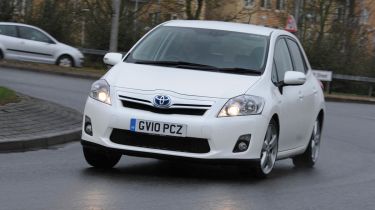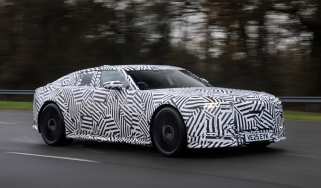Toyota Auris HSD
Petrol-electric hybrid claims to offer best of both worlds. Can it deliver?
After sampling an all-electric model and an economical diesel, is the combination of a combustion engine and an electric motor the perfect compromise?
Engineers at Toyota certainly think so. For the past decade, the firm’s groundbreaking Prius hybrid has been the highest-profile green machine on the planet, and the Auris HSD uses the same technology.
See our video review of the Auris from the EU launch in Portugal:
[[{"type":"media","view_mode":"content_narrow","fid":"75957","attributes":{"alt":"","class":"media-image"}}]]
Launched last year, the British-built model packages this advanced drivetrain in a conventional family hatchback body. That’s fine if you want to take a low-key approach, but anyone who prefers to make a statement with their green car may find the Auris a little anonymous. Still, look closely and you’ll spot hybrid badging and blue-tinted Toyota logos. The interior is equally traditional,
and family drivers will feel immediately at home.
The front of the cabin is dominated by the swooping centre console, and the dashboard features a handy double glovebox. If only the interior quality was better.
Some of the plastics are on the brittle side, while the shiny silver-effect trim looks cheap.
It lags way behind the Golf in this respect. You do get a decent multifunction steering wheel, while the neat instrument dials and stubby gear selector for the CVT transmission provide the biggest clues to the petrol-electic drivetrain lurking beneath.
Used - available now
There’s no rev counter, and the needle on the left-hand analogue dial glides between Charge, Eco and Power markings in response to your driving style. Coast or brake, and it moves towards Charge. Maintain steady throttle control, and it rests in the green Eco area, while hard acceleration sends the dial into the Power section as the electric motor helps to boost performance.
A display in the centre of the speedo also tells you whether you’re charging the battery, using the engine, or running solely on electric power. In gentle driving, the 1.8-litre VVT-i unit is hushed. But put your foot down, and the revs rise as the CVT box goes for peak power. This compromises refinement, and is in stark contrast to the silent, instant electric progress of the Leaf and
the flexible torque of the Golf.
The Toyota does have a trick up its sleeve, though. When there is sufficient charge in the battery, it can be driven in full zero-emission mode at speeds of up to 30mph. If you up the pace, the engine will fire up to lend its muscle. It’s a feature that sets the HSD apart from its VW rival, and makes it best suited to low-speed urban driving.
With a combined power output of 134bhp, performance is more than adequate. However, the manual Golf was quicker in our in-gear tests, and feels more responsive than the automatic Auris. It’s also more composed dynamically than the Toyota.
The steering feels artificial, and there’s little in the way of connection to the road, while the ride is overly firm. Most frustrating of all are the brakes, which provide inconsistent responses, making it difficult to scrub off speed progressively.
Plus, while the Auris doesn’t suffer the range limitations of the Nissan, it fails to set the world alight at the pumps. Our return of 40.2mpg was disappointing.
Details
Chart position: 3
WHY: Take the petrol-electric powertrain of a Prius, stir in an Auris hatchback, and you’ve got the recipe for the most convincing small family hybrid on the market.







